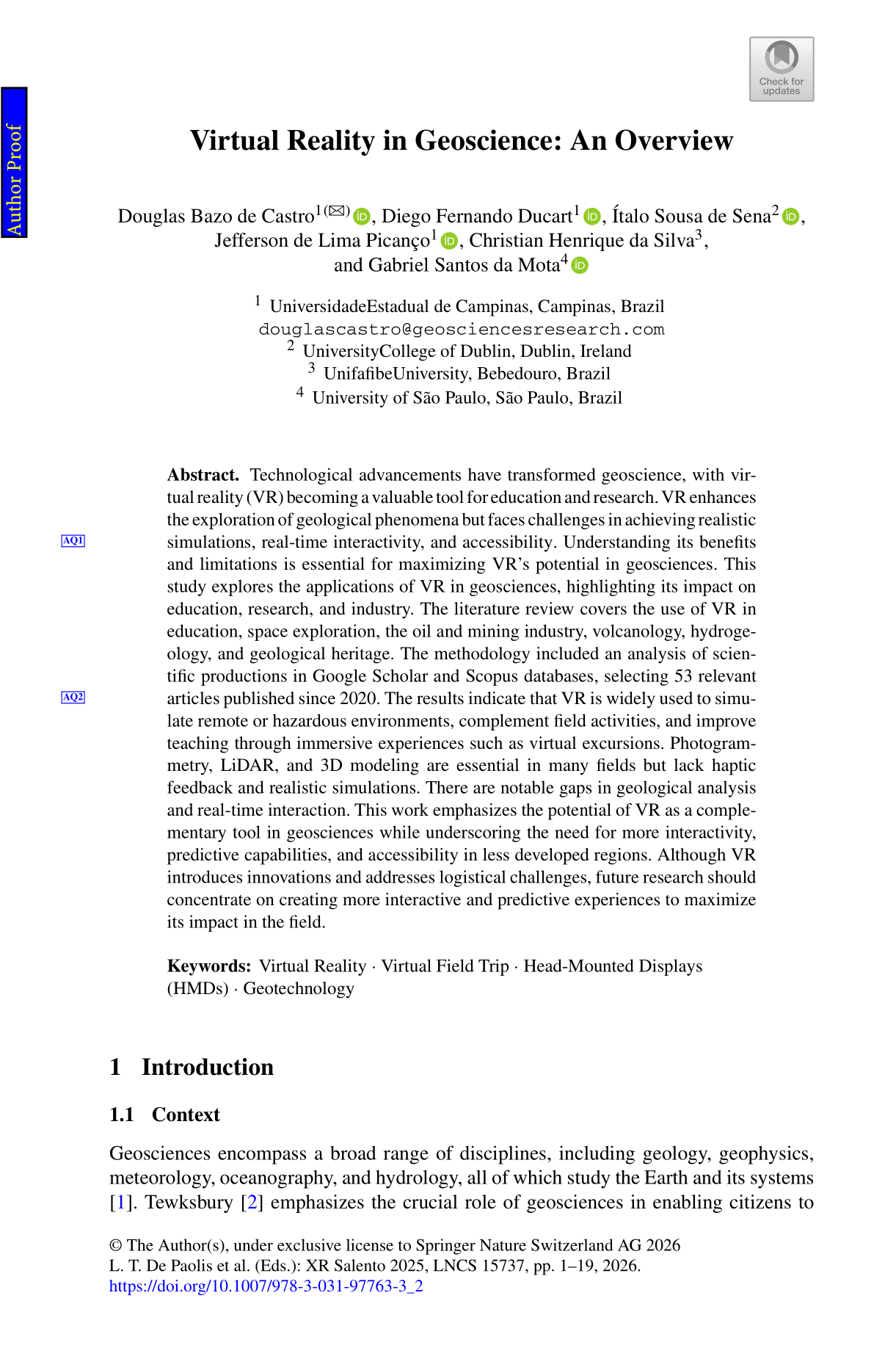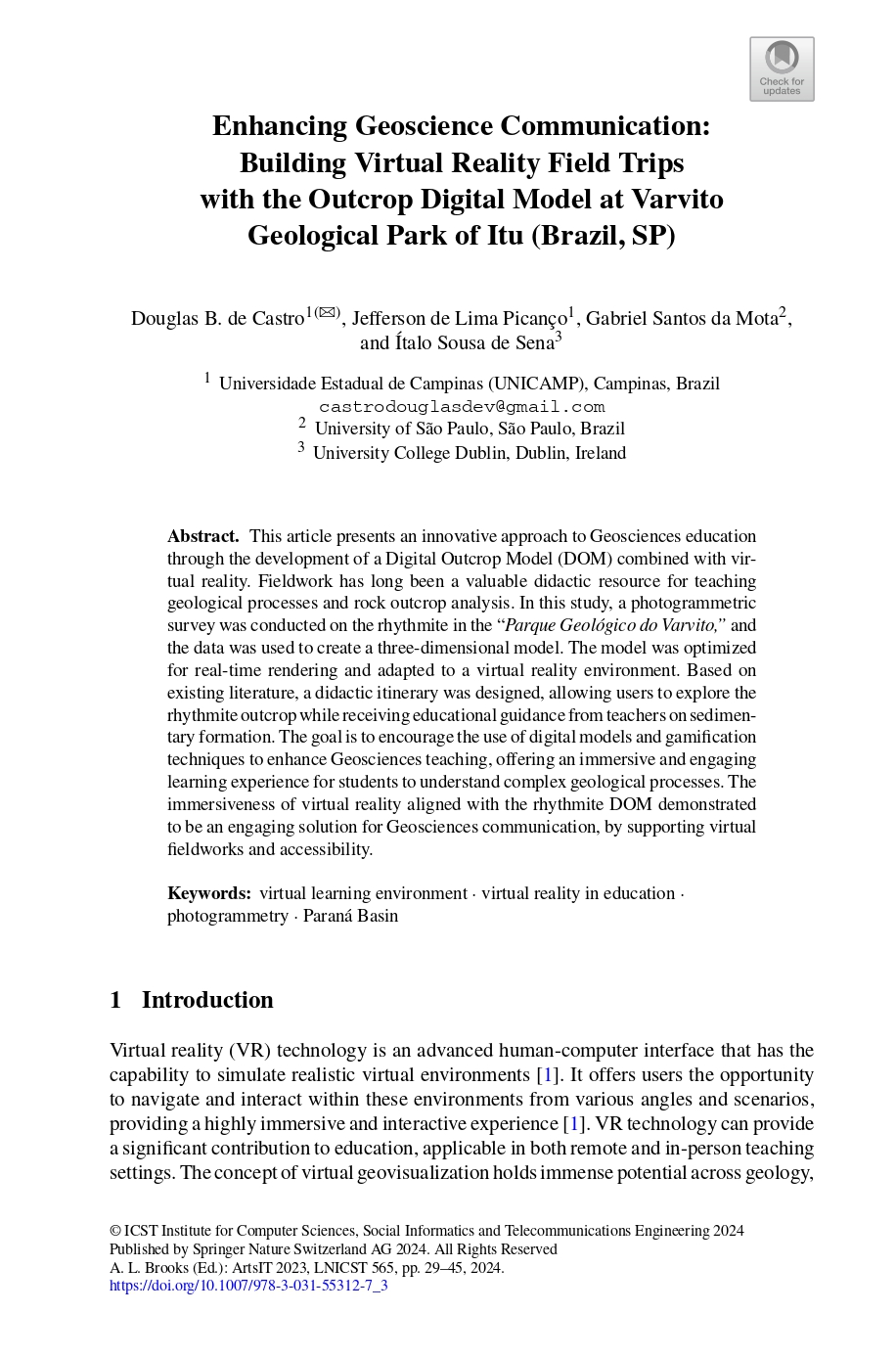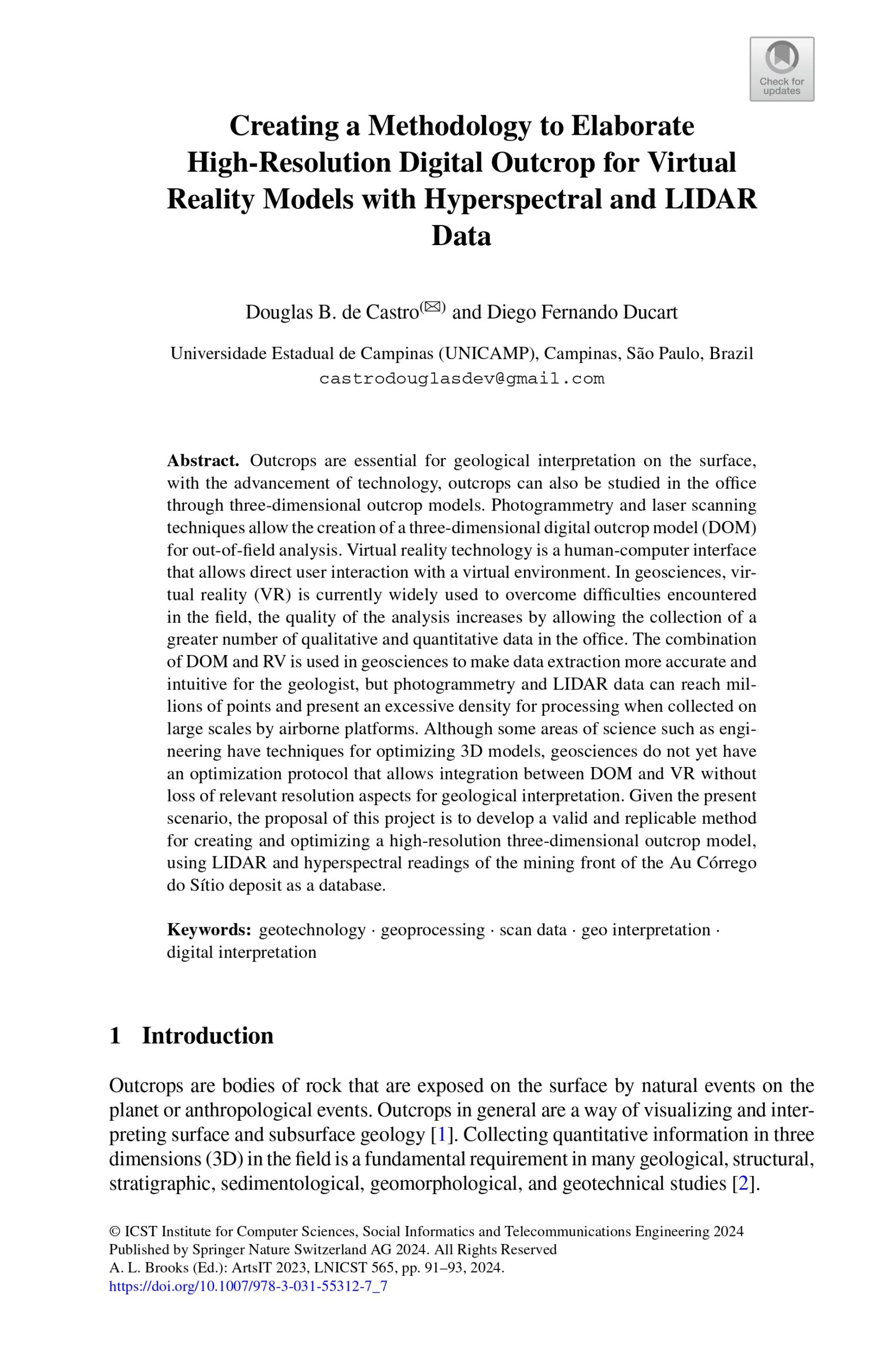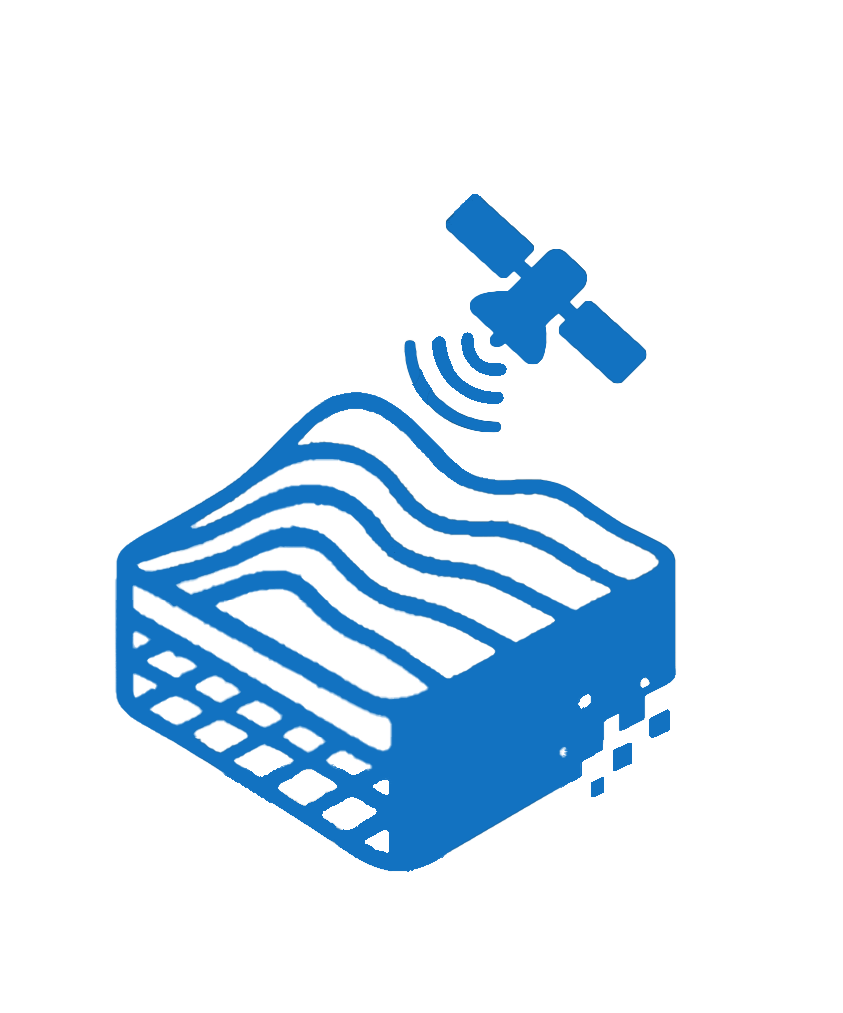First Author, Peer-Reviewed Articles

Lecture Notes in Computer Science LNCS (ACCEPTED)
Virtual Reality in Geoscience: An Overview
DOI coming in 08/13
Abstract. Technological advancements have transformed geoscience, with virtual reality (VR) becoming a valuable tool for education and research. VR enhances the exploration of geological phenomena but faces challenges in achieving realistic simulations, real-time interactivity, and accessibility. Understanding its benefits and limitations is essential for maximizing VR’s potential in geosciences. This study explores the applications of VR in geosciences, highlighting its impact on education, research, and industry. The literature review covers the use of VR in education, space exploration, the oil and mining industry, volcanology, hydrogeology, and geological heritage. The methodology included an analysis of scientific productions in Google Scholar and Scopus databases, selecting 53 relevant articles published since 2020. The results indicate that VR is widely used to simulate remote or hazardous environments, complement field activities, and improve teaching through immersive experiences such as virtual excursions. Photogrammetry, LiDAR, and 3D modeling are essential in many fields but lack haptic feedback and realistic simulations. There are notable gaps in geological analysis and real-time interaction. This work emphasizes the potential of VR as a complementary tool in geosciences while underscoring the need for more interactivity, predictive capabilities, and accessibility in less developed regions. Although VR introduces innovations and addresses logistical challenges, future research should concentrate on creating more interactive and predictive experiences to maximize its impact in the field.

lecture notes of the institute for computer sciences
Enhancing Geoscience Communication: Building Virtual Reality Field Trips with the Outcrop Digital Model at Varvito Geological Park of Itu (Brazil, SP)
Abstract. This article presents an innovative approach to Geosciences education through the development of a Digital Outcrop Model (DOM) combined with virtual reality. Fieldwork has long been a valuable didactic resource for teaching geological processes and rock outcrop analysis. In this study, a photogrammetric survey was conducted on the rhythmite in the “Parque Geológico do Varvito,” and the data were used to create a three-dimensional model. The model was optimized for real-time rendering and adapted to a virtual reality environment. Based on existing literature, a didactic itinerary was designed, allowing users to explore the rhythmite outcrop while receiving educational guidance from teachers on sedimentary formation. The goal is to encourage the use of digital models and gamification techniques to enhance Geosciences teaching, offering an immersive and engaging learning experience for students to understand complex geological processes. The immersiveness of virtual reality aligned with the rhythmite DOM demonstrated to be an engaging solution for Geosciences communication, by supporting virtual fieldworks and accessibility

lecture notes of the institute for computer sciences
Creating a Methodology to Elaborate High-Resolution Digital Outcrop for Virtual Reality Models with Hyperspectral and LIDAR Data
Abstract. Outcrops are essential for geological interpretation on the surface, with the advancement of technology, outcrops can also be studied in the office through three-dimensional outcrop models. Photogrammetry and laser scanning techniques allow the creation of a three-dimensional digital outcrop model (DOM) for out-of-field analysis. Virtual reality technology is a human-computer interface that allows direct user interaction with a virtual environment. In geosciences, virtual reality (VR) is currently widely used to overcome difficulties encountered in the field, the quality of the analysis increases by allowing the collection of a greater number of qualitative and quantitative data in the office. The combination of DOM and RV is used in geosciences to make data extraction more accurate and intuitive for the geologist. Still, photogrammetry and LIDAR data can reach millions of points and present an excessive density for processing when collected on large scales by airborne platforms. Although some areas of science, such as engineering, have techniques for optimizing 3D models, geosciences do not yet have an optimization protocol that allows integration between DOM and VR without loss of relevant resolution aspects for geological interpretation. Given the present scenario, this project proposes to develop a valid and replicable method for creating and optimizing a high-resolution three-dimensional outcrop model, using LIDAR and hyperspectral readings of the mining front of the Au Córrego do Sítio deposit as a database.
Conferences
![[IGC 2024] Certificate of Presentation_Douglas DE CASTRO-1 [IGC 2024] Certificate of Presentation_Douglas DE CASTRO-1](https://geosciencesresearch.com/wp-content/uploads/2025/06/IGC-2024-Certificate-of-Presentation_Douglas-DE-CASTRO-1.png)
Lecture Notes in Computer Science LNCS (ACCEPTED)
Virtual Reality in Geoscience: An Overview
DOI coming in 08/13
Abstract. Technological advancements have transformed geoscience, with virtual reality (VR) becoming a valuable tool for education and research. VR enhances the exploration of geological phenomena but faces challenges in achieving realistic simulations, real-time interactivity, and accessibility. Understanding its benefits and limitations is essential for maximizing VR’s potential in geosciences. This study explores the applications of VR in geosciences, highlighting its impact on education, research, and industry. The literature review covers the use of VR in education, space exploration, the oil and mining industry, volcanology, hydrogeology, and geological heritage. The methodology included an analysis of scientific productions in Google Scholar and Scopus databases, selecting 53 relevant articles published since 2020. The results indicate that VR is widely used to simulate remote or hazardous environments, complement field activities, and improve teaching through immersive experiences such as virtual excursions. Photogrammetry, LiDAR, and 3D modeling are essential in many fields but lack haptic feedback and realistic simulations. There are notable gaps in geological analysis and real-time interaction. This work emphasizes the potential of VR as a complementary tool in geosciences while underscoring the need for more interactivity, predictive capabilities, and accessibility in less developed regions. Although VR introduces innovations and addresses logistical challenges, future research should concentrate on creating more interactive and predictive experiences to maximize its impact in the field.

lecture notes of the institute for computer sciences
Enhancing Geoscience Communication: Building Virtual Reality Field Trips with the Outcrop Digital Model at Varvito Geological Park of Itu (Brazil, SP)
Abstract. This article presents an innovative approach to Geosciences education through the development of a Digital Outcrop Model (DOM) combined with virtual reality. Fieldwork has long been a valuable didactic resource for teaching geological processes and rock outcrop analysis. In this study, a photogrammetric survey was conducted on the rhythmite in the “Parque Geológico do Varvito,” and the data were used to create a three-dimensional model. The model was optimized for real-time rendering and adapted to a virtual reality environment. Based on existing literature, a didactic itinerary was designed, allowing users to explore the rhythmite outcrop while receiving educational guidance from teachers on sedimentary formation. The goal is to encourage the use of digital models and gamification techniques to enhance Geosciences teaching, offering an immersive and engaging learning experience for students to understand complex geological processes. The immersiveness of virtual reality aligned with the rhythmite DOM demonstrated to be an engaging solution for Geosciences communication, by supporting virtual fieldworks and accessibility


